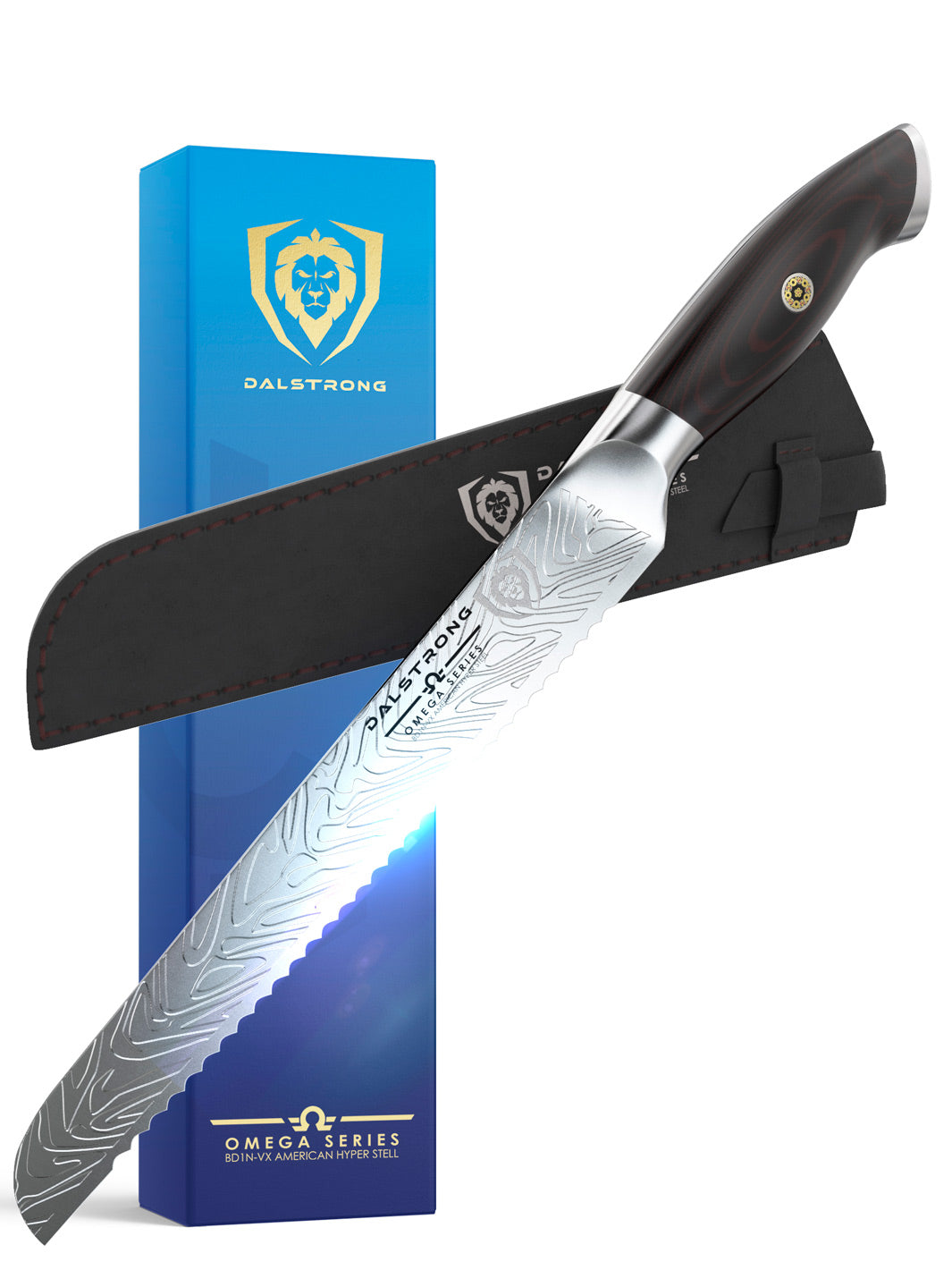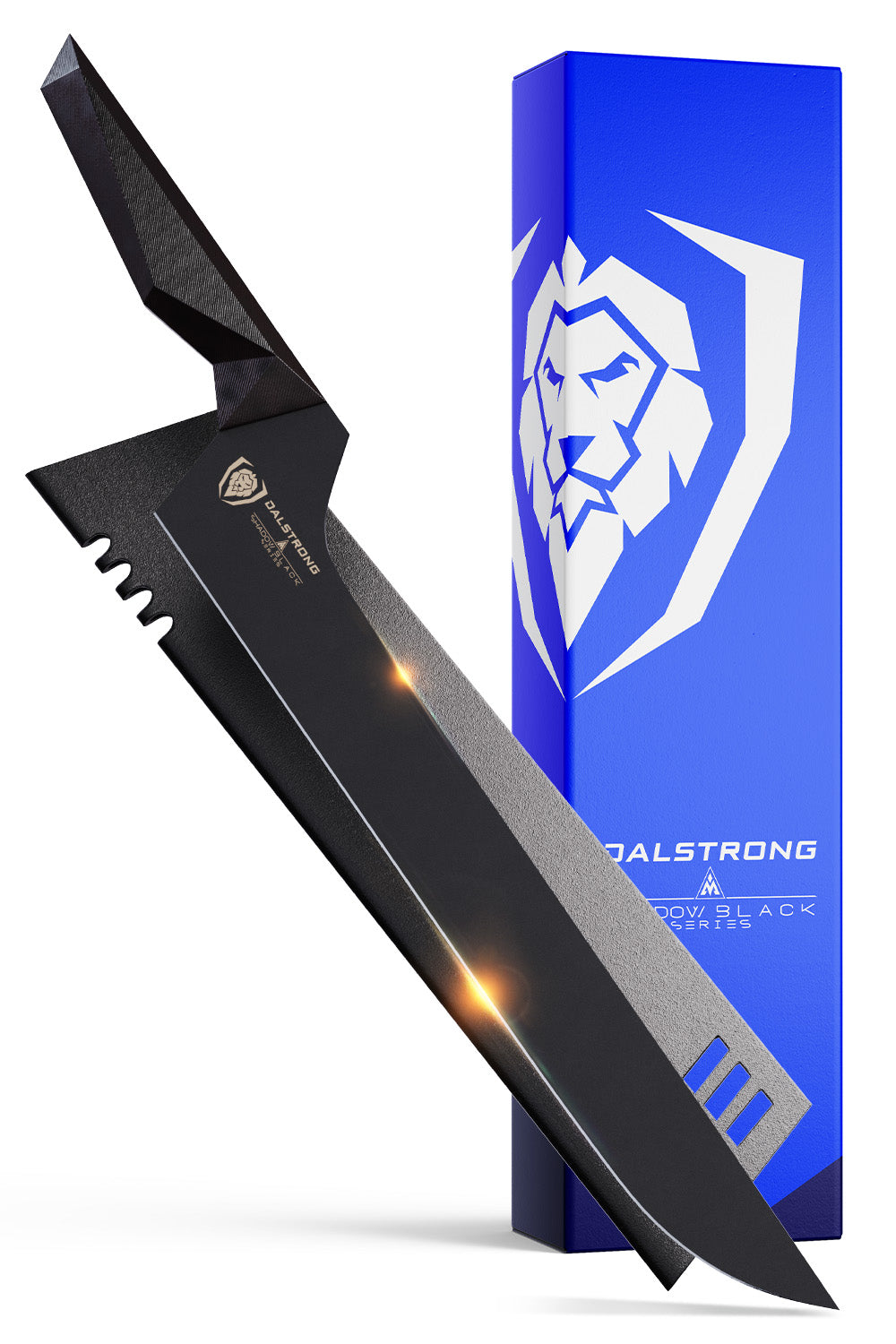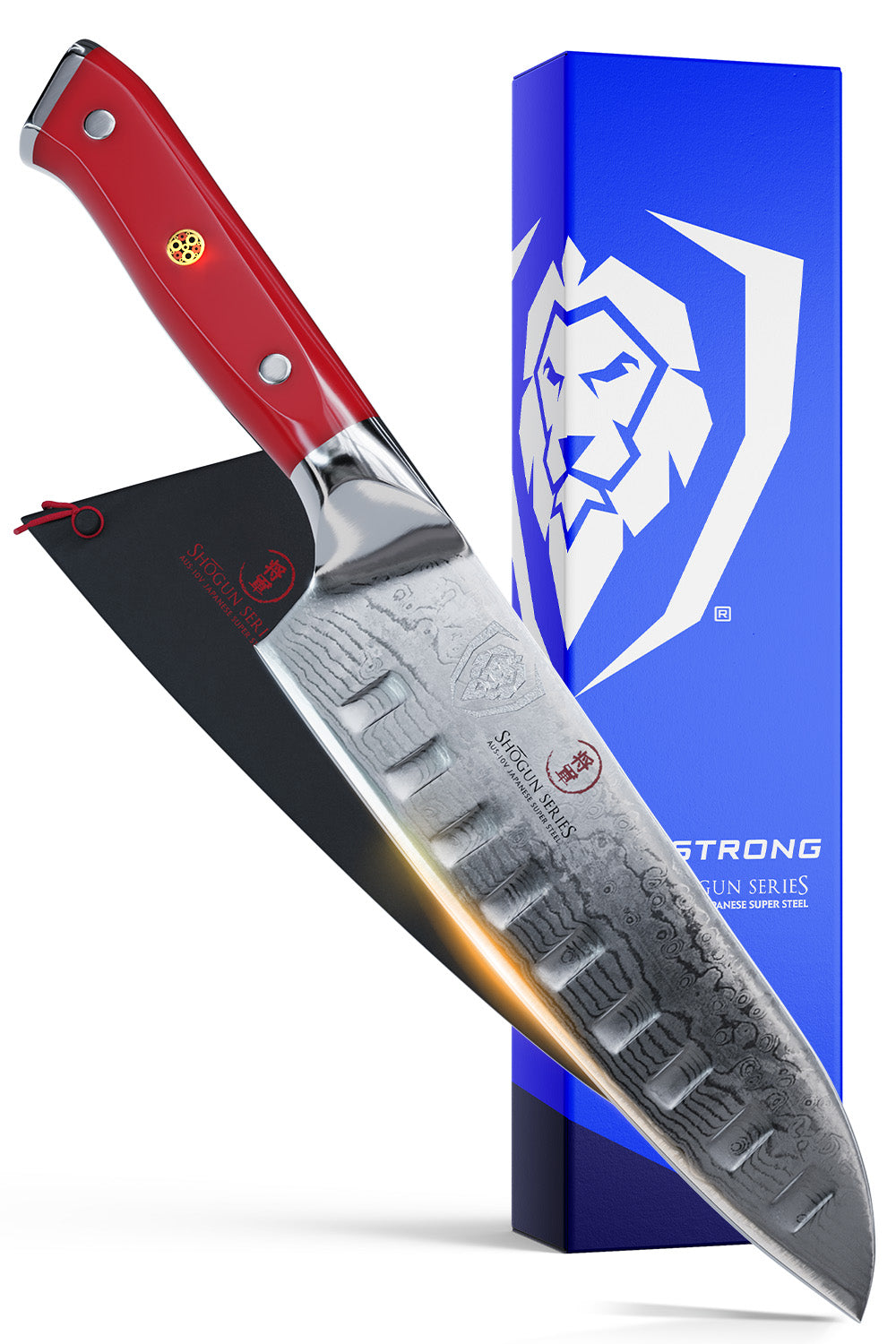BBQ Pitmaster & Meat Knife 8" with Forked Tip & Bottle Opener | Shogun Series
7 Butcher Knives You Will Want To Own
- BBQ Pitmaster & Meat Knife 8" with Forked Tip & Bottle Opener | Shogun Series
- Butcher's Breaking Cimitar Knife 10" | Gladiator Series
- Butcher's Breaking Cimitar Knife 12" | Gladiator Series
- Butcher & Breaking Cimitar Knife 14" | Gladiator Series
- Bull Nose Butcher Knife 8" | Shogun Series
- Bull Nose Butcher Knife 10" | Gladiator Series
- Butcher & Breaking Cimitar Knife 8" | Gladiator Series
8'' Butcher & Breaking Cimitar Knife | Gladiator Series | Dalstrong ©
Not all knives are created equal. And not all knives can be used equally well for all things. One of the most impressive knives out there is the butcher knife.
I am sure that at some time you have noticed a large kitchen knife, with a long, curved blade and a durable handle being used to cut meat. Maybe you have seen your local butcher using it to slice through raw meat on their cutting board. Or a chef using it to break off brisket from the bone. Well, that knife is the butcher knife, and it is meant for butchering and cutting down and stripping meat from the bone.
Now, it is time to stop admiring the butcher knife from afar, and to learn about what specifically it is used for and which one is the right one for you to add to your kitchen cutlery arsenal.
Content Table
- What is a butcher knife
- What to look for in a butcher knife
- How to use a butcher knife
- 7 butcher knives you will want to own
- Frequently asked questions
1. What Is A Butcher Knife?
14'' Butcher & Breaking | Gladiator Series | Dalstrong ©
A butcher knife is a large kitchen knife with a long, curved blade. It is best utilized for cutting meat. While some may use a chef’s knife for this task, a butcher knife is specifically designed for butchering and breaking down big pieces of cooked or raw meat.
The butcher knife features a long, curved steel blade, which makes it ideal for making smooth slices and getting around bone. Butcher knives have strong steel blades, which make them a more powerful and durable kitchen tool.
There are several varieties of butcher knives, including the breaking knife, boning knife, meat cleaver, and of course, the traditional butcher knife.
2. What To Look For In A Butcher Knife
Bull Nose Butcher Knife 8" | Shogun Series
When considering butcher knives, you must pay attention to the following: balance, blade, size and handle.
-
Balance: Some butcher knives feature a full tang. A full tang refers to the solid piece of metal that makes up the blade running down the handle, as well. Powerful knives, like the butcher knife, benefit from this because it offers the user more control of the knife. Balance and control are of the utmost importance when handling butchering cutlery to slice and break up meat.
-
Blade: The thick, steel blade of a butcher knife allows you to cut through your meat without chipping or breaking the blade. Some of these steel blades have a small curve to them, offering you the flexibility of a boning or filleting knife. This added maneuverability allows you to get around the bone.
-
Sharpness: Choose a high carbon stainless steel blade. Make sure it is from a trustworthy brand known for blades that exhibit strength and durability. Finally, don’t forget edge retention. Look for a blade with a Rockwell hardness of 56+.
-
Size: In the world of butcher knives, size does matter. Most knives are between 6” and 14”. The smaller knives offer more flexibility, and allow you to get around the bone with ease. They might marry the power of the butcher knife, with the maneuverability of a paring knife. The longer blades offer more power. They will allow you to chop, cut or skin with greater ease of motion.
-
When choosing the size of your butcher knife, consider how you will use it. Do you travel with your cutlery? If so, a smaller knife might be more convenient. Are you breaking down big cuts or wild game-- a bigger blade might do the trick. While there is no hard-fast rule, often home chefs rely on knives between 8” and 10”, while professionals lean toward a larger model.
- Handle: When considering a knife handle, think about what material is most comfortable for you. Handles range from plastic, steel, to wooden. While wooden handles might seem more standard, they require more maintenance. Look for an ergonomic handle, textured for added grip. This can be important, as butchering gets messy, and a firm grip means control and balance no matter the conditions. When considering a handle for your cutlery, it needs to be comfortable and safe.
- Style: Aesthetics are important too. When handling your butcher knife, you want to do it in style. So, consider material, size, and color when making your choice. Regardless of your personal style, Dalstrong has you covered. From the more traditional to the sleek, aggressive and modern, there is a butcher knife that meets your taste. Some might prefer their steel blade to be clean, while others like a stamped blade. Some look for a serrated edge. Others prefer a straight edge.
Regardless of personal style, you want your knife to handle your butchering needs and look good in the process. You want a knife that stands out in the knife block, or on the cutting board, and shows off your butchering prowess.
3. How To Use A Butcher Knife
Bull Nose Butcher & Breaking Knife 8" | Gladiator Series
Once you realize how imperative the butcher knife is to your knife set and purchase one, you will need to know how to use it. Whether we are talking about a traditional butcher knife, meat cleaver, breaking knife, or boning knife, or the blade is 8 or 14 inches, there are some general guidelines to follow.
Use caution
Knife safety is always our number one priority. Get to know your knife. Make sure you are secure with its grip, balance, and sharpness. Always stay alert while cutting, slicing and chopping.
The Grip
The most common way of holding a butcher knife is using a method called the pinch grip. The pinch describes pinching the base of the blade with your finger and your thumb. You can also hold the handle firmly and curl your index finger all the way around it in order to protect it. Make sure that you remain comfortable and continue to exercise safety measures regardless of the grip you choose.
Using the tip
The tip of the blade is generally used for getting in between the meat and the skin.
Using the curved part of the blade
You will use this part of the blade to further separate the meat and the skin, after you begin the separation with the tip. The curved part is also good at navigating around the bone.
Using the full length of the blade
This part of your stainless steel blade is used for making long clean slices. You can work horizontally to trim the meat or vertically to chop it.
General rules
Keep your steel blade sharp, and maintain its sharp edge. Remember to compliment your new butcher knife with a quality cutting board to help maintain the longevity of your blade.
4. 7 Butcher Knives You Should Own
Here are some of our recommendations for top of the line butcher knives:
1. BBQ Pitmaster & Meat Knife 8" with Forked Tip & Bottle Opener | Shogun Series
Barbecuers unite, this one’s for you. The Shogun Series 8” Pitmaster knife is thoughtfully designed with a personal nod to our loyal BBQ community. This 9” full-tang knife is meticulously handcrafted of high-carbon Japanese AUS-10V Super Steel, with a scalpel-sharp blade edge ideal for slicing, butchering and serving all of your favourite meats; from tomahawk steaks to briskets, ribs, roasts, poultry, fish and more.
Glide through your award winning bbq with ease and keep all the juices inside with 13 thoughtfully designed shallow dimples that minimize suction and stuck-on foods. This all-in-one versatility master is an essential addition to any serious Pitmaster, self-proclaimed or otherwise. A one-of-a-kind design, this blade features a unique forked front end, ideal for flipping meat directly on the grill, and for transferring foods cooked to perfection from plate to hot grill or hot grill to plate.
Pros:
- Hand-polishing reveals a magnificent visual pattern, Dalstrong’s‘Tsunami Rose’.
- The super-steel core possesses extra high carbon levels, allowing for scalpel-like sharpness with exceptionally long lasting edge retention.
- Cleans easily for low maintenance.
- Resistant to both extreme hot and cold temperatures for long-term durability.
Cons:
- G-10 Garolite handle might not meet everyone’s personal style.
- Might not fit everyone’s butcher knife budget.
2. Butcher & Breaking Cimitar Knife 14" | Gladiator Series

This extra long bladed butcher and breaking knife is specially designed to manage even your largest cuts of meat. This stainless steel beauty effortlessly slices through large game meats such as moose, elk, deer, as well as smaller cuts of beef, pork, poultry, and fish. This butcher knife features a beautiful, ergonomic and ambidextrous black G10 Garolite Handle, which is highly impervious to heat, cold, and moisture, the Gladiator Series 14" cimitar is carefully designed for maximum comfort and maneuverability. It also is extremely durable and easy to maintain.
Pros:
- Precision forged, razor sharp German steel blade, which features a Rockwell hardness of 56+
- Tall blade height gives knuckle clearance to assist with food preparation and chopping activity
- Triple riveted for even more durability
- Easy to clean and maintain
Cons:
- Might be too much knife for those who are not looking for a 14” blade
- Might lack the flexibility and maneuverability of smaller butcher or breaking knives
3. Butcher's Breaking Cimitar Knife 10" | Gladiator Series
This Gladiator series’ butcher’s breaking knife will be your workhouse and sidekick whenever you are aiming to prepare steak, brisket, game or really any type of meat. It features a razor sharp high carbon blade for making easy work of your slicing and cutting.
This butcher knife’s beautiful, ergonomic and ambidextrous black G10 Garolite handle, with full tang and triple-riveted grip, offers you the ability to perform your butchery work with efficiency and precision. It can also double as your carving knife. Included with this knife is a BPA-free PerfectFit knife guard for the blade's protection. This Cimitar is a powerhouse of a butcher knife to add to your knife set.
Pros:
- The edge is painstakingly hand sharpened to 16-18° per side, maintaining the perfect balance between blade sharpness and maximum resilience
- Tapered design for hardness and flexibility
- Cleans easily and is low-maintenance
- Stainless steel second bolster (end cap) adds counter balance and distinction
Cons:
- Blade might not be large enough for those looking to take on big game
- Lacks the unique style of some other models
4. Butcher's Breaking Cimiter Knife 12" | Gladiator Series
Break down even the largest cuts of meat with lightning speed with the Gladiator Series 12” Butcher & Breaking Knife – a master in nose to tail sectioning and portioning. Effortlessly glide through larger game meats such as elk and moose, as well as smaller cuts of beef, pork, poultry.
Slice through juicy steaks like butter and achieve clean, picture perfect, paper-thin brisket slices with this knife – an essential knife for all pitmasters, butchers, and chefs. The scalpel-like curved blade edge is designed to create leverage to complete cuts in a smooth, single motion without sawing, allowing even the busiest of butcher’s to work faster, longer.
Pros:
- Rock-hollow divots, which minimize adhesion to prevent stuck on food and reduce friction for a more comfortable cutting experience.
- Precisely tempered for added durability.
- Beautiful, ergonomic and ambidextrous black G10-Garolite handle, with full tang and triple riveted.
- Added chromium for stain resistance.
Cons:
- Some chefs may want a smaller knife instead of a 12" knife.
5. Bull Nose Butcher Knife 8" | Shogun Series
This Bull Nose butcher knife features a conservative 8” blade to give chefs more control, while reducing fatigue. Think of this knife when you have time-consuming butchering to do.
A rounded tip helps when you are slicing through meat. You will have no problem cutting through cartilage and trimming fat from beef, pork, poultry, fish and breaking down large game, without getting your blade lost in the meat. The carefully engineered ergonomic handle is designed for superior hand control and comfort. And the gorgeous copper mosaic pin, which adorns the center rivet will add a touch of elegance to your knife set.
Pros:
- Scalpel-like sharpness at a staggering 8-12°degree angle per side. Sail through culinary challenges.
- Incredible Edge Retention at 62+ Rockwell
- Military grade G10 handle for life-long durability
- Easy to clean and maintain
Cons:
- Smaller blade might not meet the needs of all chefs
- Design might not meet more conservative tastes
6. Bull Nose Butcher Knife 10" | Gladiator Series
A welcome addition to any butcher or serious chef’s arsenal, the Dalstrong Gladiator Series 10” professional breaking knife is a powerhouse in nose to tail sectioning and portioning, allowing you to glide through steak like butter, trim briskets effortlessly and break down large game without getting lost in the meat.
The Gladiator Series blade is precision forged from a single piece of imported premium quality, high-carbon ThyssenKrupp German steel, ensuring an ultra sharp edge which is hand sharpened to between 16-18 degrees, with excellent wear and stain resistance. The curved blade is designed to create leverage, and complete cuts in a single motion without sawing.
Pros:
- Precision forged, ultra sharp, wear resistant, single-piece, high carbon German ThyssenKrupp Steel at 56+ Rockwell.
- The edge is painstakingly hand sharpened to 16-18° per side, maintaining the perfect balance between blade sharpness and maximum resilience.
- Cleans easily for low maintenance.
- Tall blade height gives knuckle clearance to assist with food preparation and chopping activity.
Cons:
- Some chefs may want to go with Japanese steel versus German steel.
- Light design might not be a fit for those used to heavier butcher knives.
7. Butcher & Breaking Cimitar Knife 8" | Gladiator Series

A slightly more conservative 8” blade offers you control and maneuverability, while maintaining a razor sharp high carbon steel blade. This Gladiator can do it all. From trimming brisket, to trimming down large game, or slicing through steak, this knife will make quick work of the meat on your cutting board.
This kitchen knife features great balance. It is perfectly weighted to handle both thicker, heavy duty cuts and more delicate detail work. Its military grade G10 handle offers life-long durability and easy comfort. All this makes this Gladiator series butcher knife a great fit for your knife set.
Pros:
- Tall blade height gives knuckle clearance to assist with food preparation and chopping activity
- Razor sharp and extremely resilient
- Easy to clean and maintain
- Reduces fatigue for longer butchering tasks
Cons:
- Some may be looking for a larger blade
- Slimmer than some other butcher knives on this list
5. Frequently Asked Questions
Bull Nose Butcher Knife 10" | Gladiator Series
What is a butcher's knife used for?
A butcher’s knife is used for chopping and breaking down meat. It is also used to cut meat from the bone. Many blades have a slight curve, allowing the butcher to slice the meat more efficiently.
What is the best butcher knife?
The best butcher knife is a high quality one, which utilizes carbon steel or stainless steel. It is razor sharp, and features excellent edge retention. This butcher knife would also have a graspable, ergonomic handle that helps you balance and control the knife.
There are many styles of butcher knife, so the ideal, or best one, is a matter of taste and task. But quality materials and a trustworthy brand will lead you to a high performing butcher knife.
What knives do butcher's use?
Butchers use traditional butcher knives, cleavers, carving knives, and breaking knives. They also utilize boning knives, paring knives, fillet knives, bread knives, utility knives, steak knives and chef knives.
What is the difference between a butcher knife and a cleaver?
Because people often use the cleaver as a butcher knife, it, along with the breaking and carving knife, is commonly lumped into that category of knives. They are both large knives with a lot of steel in the blade. They are known for their power, and used for cutting meat from the bone. However, because there are several styles of butcher knives, not all butcher knives are cleavers.
What is the difference between a butcher knife and a chef knife?
While a chef’s knife may be used for some butchering tasks, the butcher knife’s long, curved blade sets it apart. Normally, the butcher knife is heavier, more powerful, and larger than a chef knife. As the butcher knife has been designed with the intention of separating meat from the bone. One caveat is that because these are types of knives, rather than specific knives, there are differences in how any one butcher knife differs from any one chef knife.
Check Out Dalstrong Butcher Knives Today
Written by Jonathan ScolnickBorn in Philadelphia and living in Argentina, Jonathan loves learning about culture through the food and conversation at the dinner table.



















